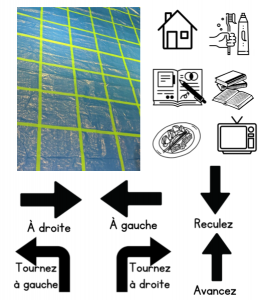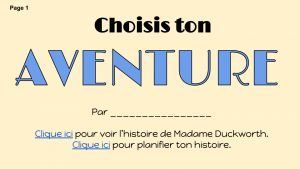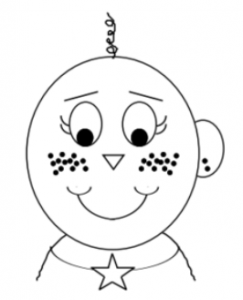To date, I’ve written two posts (here and here) with sample comments for the Learning Skills section of the Ontario report card. Those are arguably the most difficult comments to write, but I’ve also found French language comments to be challenging. I change my style and choices every year, it feels like, so these are by no means perfect, but I thought some of you may like to see some of the comments I use for reporting on French Immersion and Core French. Use bits of these, adapt them, share them – these are here for your reference and to help you out!
Program: Middle French Immersion (year 2) – Term: Progress Reports – Profile: Progressing With Difficulty (D-level)
(NAME) is making some progress in the grade 5 Middle French Immersion program, although she requires considerable encouragement to engage with the class during instructional time. With frequent support, she is beginning to speak in French with her teacher and peers. She should strive to make use of in-class supports (e.g., anchor charts, notes, word wall) to assist her with her learning. Continued reading at home (preferably aloud) will help her to develop stronger reading skills.
In subjects where the language of instruction is French, (NAME) consistently needs one-on-one assistance to understand the material being taught and complete her work. Going forward, she would benefit from developing listening strategies to help her understand what is being taught (such as listening for key words, watching the speaker, using visual supports).
Program: Middle French Immersion (year 2) – Term: Progress Reports – Profile: Progressing Well (C-level)
(NAME) is progressing well overall in the grade 5 Middle French Immersion program. With one-on-one or small group assistance, he is usually able to demonstrate an understanding of the material discussed in class. He makes good connections between what he is learning in class and his personal experiences. Oral communication is an area of need for (NAME) as he requires frequent support when speaking spontaneously. He would benefit from using a variety of speaking strategies (e.g., hand gestures, visual supports, rephrasing) to communicate his ideas without substituting English words. (NAME)’s writing strategies are developing well, and he makes good use of classroom resources (e.g., Word Reference, anchor charts, notes) to complete his work.
Program: Middle French Immersion (year 2) – Term: Progress Reports – Profile: Progressing Well (B-level)
(NAME) is progressing well so far in the Middle French Immersion program. He is beginning to speak with more confidence in rehearsed situations, such as prepared presentations. When speaking, he is usually able to communicate his thoughts and ideas effectively, although he sometimes needs encouragement to persevere in French when the vocabulary is less familiar. He can work on improving his communication skills by using speaking strategies (e.g., using gestures, finding another way to say a word, using anchor charts) to avoid resorting to using English in class.
Program: Middle French Immersion (year 3) – Term: Progress Reports – Profile: Progressing Very Well
(NAME) is progressing very well so far in the Middle French Immersion program. She is a highly effective communicator and speaks with confidence in both spontaneous and rehearsed situations. When writing, she is able to use the self-revision checklist (POMMES) to correct any errors in her text. She can work to improve her speaking skills by striving to speak only in French during class time.
Program: Middle French Immersion (year 3) – Term: 2 – Profile: Significant difficulty, little progress
(NAME) continues to demonstrate significant difficulty in French-language subjects. She has missed a large amount of French instruction time this term due to late arrivals and absences, which has hindered her development as she has missed many opportunities to practice her French skills in class discussions and group work. (NAME) is reluctant to speak French in class, rarely even using common phrases such as asking to use the washroom, though with encouragement she will sometimes form short sentences when speaking to teachers. She consistently requires one-on-one support to understand lessons. When reading, she shows surface-level understanding of texts at the Grade 6 level when supported by the teacher or her peers. Engaging (NAME) in French subjects has been a challenge this term, as she often needs reminders to stay on task. (NAME) will need to put much more effort into French subjects next year in order to catch up to where she should be. Her immediate focus should be on developing her oral communication skills, particularly speaking.
Program: MFI (year 3) – Term: 2 – Profile: B level
(NAME) demonstrates a high degree of comprehension during listening activities and discussions. She is able to follow complex instructions without assistance from her teachers. When speaking, (NAME) usually communicates her thoughts and ideas clearly. She is developing a good accent and pronounces most familiar words correctly. Overall, she speaks with some ease in spontaneous and rehearsed contexts. Going forward, she would benefit from building her confidence when speaking, which would help to develop her intonation and fluency. (NAME) is developing good writing skills. She has a wide vocabulary and is able to apply most conventions with success when creating written texts. When given feedback, she is generally able to apply that feedback and make revisions to her writing. When reading, (NAME)’s decoding and comprehension skills consistently meet the grade 6 expectations. She generally identifies the main idea and important details in a text, though at times she requires some encouragement to provide evidence from the text to support her ideas. (NAME) is encouraged to continue reading French books at her level over the summer to continue developing her reading skills.
Program: MFI (year 3) – Term: 2 – Profile: A level (shockingly similar to the B level comment… to show you how I adapt it but don’t overdo workload by completely changing wording)
(NAME) participates actively in all aspects of the French program. She demonstrates a high degree of comprehension during listening activities and discussions. She is able to follow complex instructions without assistance from her teachers. When speaking, (NAME) nearly always communicates her thoughts and ideas clearly. Her confidence allows her to speak with considerable fluency in both spontaneous and rehearsed contexts. She is developing a good accent when speaking and pronounces most familiar words correctly. (NAME) is a strong writer. She makes great use of a wide vocabulary and a good understanding of French conventions to create a variety of written texts. When given feedback, she is able to apply that feedback and successfully make revisions to her writing. Overall, (NAME) is a strong reader in French. When reading independently, her decoding and comprehension skills exceed the grade 6 expectations. She identifies the main idea and important details in texts with ease. (NAME) is encouraged to continue reading French books over the summer to continue developing her reading skills.
Program: Core French – Term: 1 – Profile: Strong academics, good engagement
(NAME) participates actively in all aspects of the Core French program. She has strong communication skills and consistently speaks in French during class activities. She has demonstrated leadership in the classroom by helping her peers when she is able to. When writing, (NAME) makes good use of classroom resources (e.g., dictionaries, models, anchor charts) to complete tasks independently. Going forward, she is encouraged to speak in French with her peers during class time to further develop her skills.
Program: Core French – Term: 1 – Profile: Good academics overall, solid B-level achievement
(NAME) is an active and enthusiastic participant in Core French activities. She uses many comprehension strategies (e.g., context clues, mots amis) to help her understand what she is hearing and reading. Using models, she can produce a variety of text types with familiar vocabulary and sentence structure. She often tries to use new vocabulary in her writing and enjoys finding new ways to say something. Overall, her oral communication skills are developing well, though she would benefit from making more of an effort to only speak in French during class activities. When speaking spontaneously, she can usually communicate her thoughts and ideas clearly. That said, she has a tendency to switch to English if she is not certain how to say something. For next term, she is encouraged to persevere and try to finish her thoughts in French without reverting to English.
Program: Core French – Term: 2 – Profile: Good effort but lower achievement, C/D level
It has been a pleasure to teach (NAME) this year. She is always ready to learn and approaches Core French activities with enthusiasm. She has made some progress with her communication skills in French this year, although she continues to need considerable assistance to complete reading and writing tasks in particular. She is starting to make good use of listening strategies to follow along with lessons and complete tasks using simple French vocabulary. (NAME) typically needs reminders to use classroom resources to help her complete her work, such as word walls and models. For next year, she is encouraged to work toward participating more frequently in class discussions and striving to use what she has learned in the classroom on a more consistent basis.
Program: Core French – Term: 2 – Profile: Limited French exposure before this year, good progress, B level
It has been a pleasure to teach (NAME) this year. He is always ready to learn and approaches Core French activities with enthusiasm most of the time. He has learned many useful listening strategies which have helped him tremendously in the class. With some assistance, he is able to understand lessons, follow instructions, and complete tasks using simple French vocabulary. He is learning quickly and puts great effort into using the language skills he has learned on a daily basis. He makes good use of classroom resources such as word walls and dictionaries, although he occasionally needs help finding the correct words to put his ideas into writing. For next year, he is encouraged to work on adding expression to his French reading now that he recognizes most common spelling patterns.
 In his presentation, my brother set up grid mats on the floor for participants. On the mat, there were a number of images that were directly related to the story about the events of a person’s day. Participants were asked to read the story and then use the cards with directional arrows to determine how they could move across the mat, landing on the images, in order of their occurrence in the person’s day. Participants mentioned that the kinesthetic nature of getting up and moving around and connecting the images to the story made it a fun way to interact with the text.
In his presentation, my brother set up grid mats on the floor for participants. On the mat, there were a number of images that were directly related to the story about the events of a person’s day. Participants were asked to read the story and then use the cards with directional arrows to determine how they could move across the mat, landing on the images, in order of their occurrence in the person’s day. Participants mentioned that the kinesthetic nature of getting up and moving around and connecting the images to the story made it a fun way to interact with the text. Given a model and a list of the vocabulary used in the unit, an extension would be for students to write their own stories to share with others in their class and have them navigate the mat to determine the code. Students could also create a game or activity whereby they use directional language and the reader has to determine the steps they took in sequential order. For example, if we are still talking about daily activities or routines, students could follow directions to determine what happened from the beginning to the end of someone’s day.
Given a model and a list of the vocabulary used in the unit, an extension would be for students to write their own stories to share with others in their class and have them navigate the mat to determine the code. Students could also create a game or activity whereby they use directional language and the reader has to determine the steps they took in sequential order. For example, if we are still talking about daily activities or routines, students could follow directions to determine what happened from the beginning to the end of someone’s day. 



